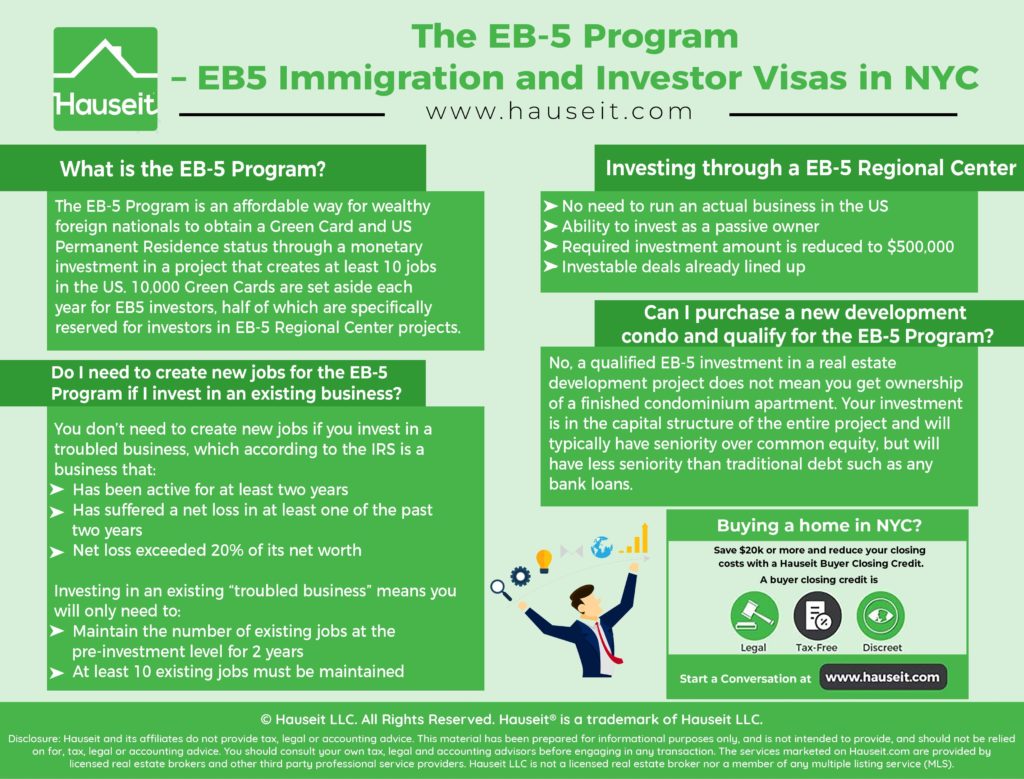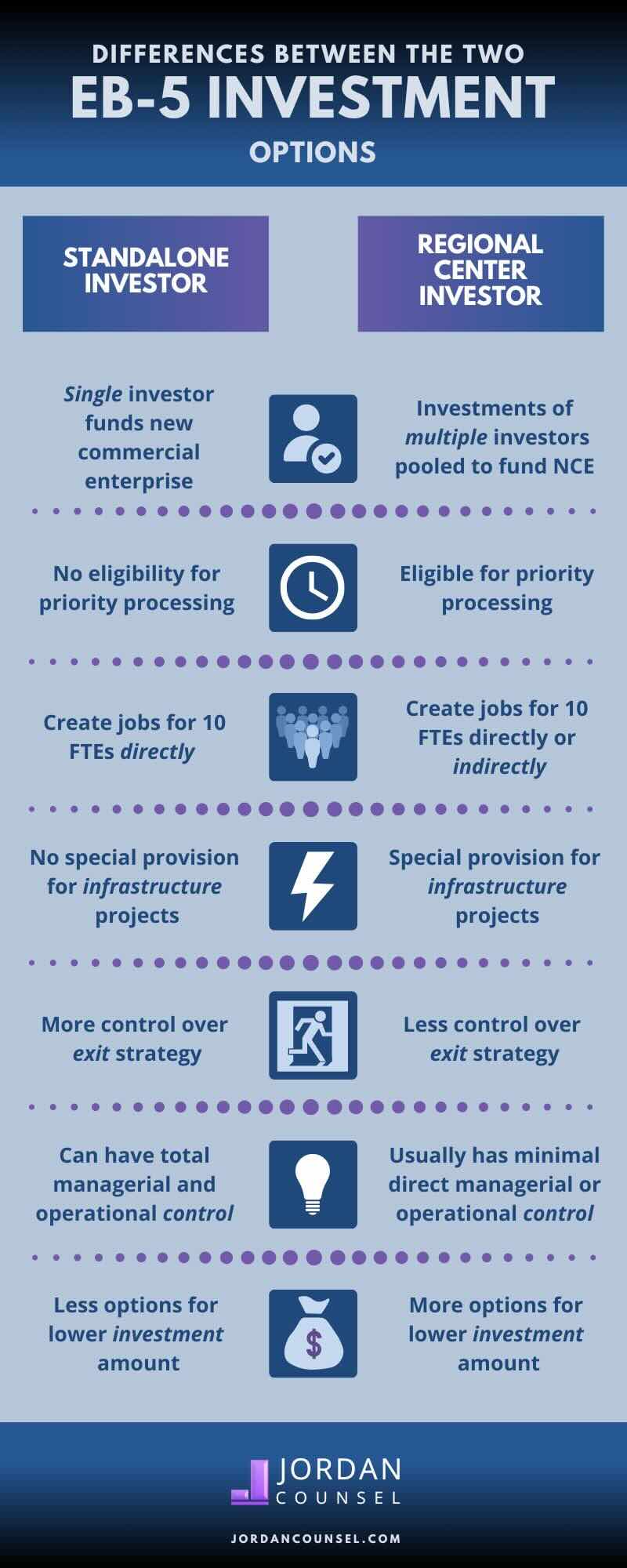EB-5 Visa Explained: Just How to Get a Visa With Financial Investment
The EB-5 Visa program offers a special possibility for international financiers looking for U.S. irreversible residency through an organized investment strategy. With certain qualification requirements and investment thresholds, the procedure calls for mindful factor to consider and tactical preparation. Recognizing the subtleties of the application procedure, including the distinctions in between regional centers and direct financial investments, is essential for potential applicants. As this path unravels, prospective capitalists need to navigate various benefits and challenges that accompany it. What are the crucial variables that can influence the success of an EB-5 application?
Summary of EB-5 Visa
The EB-5 Visa program, developed to promote the U.S. economy via international investment, offers a pathway to permanent residency for qualified financiers and their families. Developed by the Immigration Act of 1990, the program intends to attract foreign capital to develop work and improve economic growth in the USA. Financiers that contribute a minimum amount to an approved task can make an application for this visa, thus permitting them to buy various markets, including actual estate, facilities, and other business.
The EB-5 program is particularly appealing as a result of its twin benefits: an opportunity for monetary rois and the possibility for united state citizenship. By purchasing targeted work areas (TEAs), which are specified as country areas or locations with high unemployment, financiers might receive a lowered investment limit. The program needs the creation of a minimum of 10 permanent jobs for U.S. employees as a straight result of the financial investment. Successful applicants get a conditional visa for 2 years, after which they can use for irreversible residency, given they satisfy all program requirements. This path has gathered attention from investors internationally, making it a necessary component of united state immigration policy.
Eligibility Requirements
To qualify for the EB-5 Visa, investors have to meet certain eligibility requirements that guarantee their financial investment adds to job development and financial growth in the USA - EB-5 Investment Amount. Most importantly, applicants must invest a minimum of $1 million in a brand-new business, or $500,000 if the financial investment is made in a targeted work area (TEA), which is commonly defined by high unemployment or rural areas
Furthermore, the venture must preserve or create at the very least 10 permanent jobs for qualifying united state employees within 2 years of the financier's admission to the USA. Capitalists are also called for to demonstrate that their mutual fund were obtained with legal means, giving proof such as income tax return and financial institution declarations.
Another vital requirement is that the financial investment has to be in a for-profit business entity that was established after November 29, 1990, or one that has actually been reorganized or increased to satisfy the EB-5 needs. Ultimately, candidates must show their intent to actively participate in business, making sure that their involvement adds to its success. Fulfilling these eligibility demands is essential for financiers looking for to get irreversible residency with the EB-5 program.
Investment Options
When thinking about the EB-5 visa, financiers need to assess their options between straight financial investment chances and regional center programs. Each selection lugs details job production demands that are important for satisfying the visa requirements. Understanding these financial investment methods is essential for making an educated choice that aligns with both monetary goals and immigration purposes.
Direct Financial Investment Opportunities
Direct investment chances under the EB-5 Visa program offer international financiers with a path to acquire united state irreversible residency while adding to the American economic situation. Unlike regional facility financial investments, direct financial investments require capitalists to proactively manage their service endeavors within the U.S., permitting for possible greater control and influence over their financial investment end results.
To receive the EB-5 Visa through straight financial investment, international nationals have to invest a minimum of $1 million in a new business or $500,000 in a targeted work area, which is specified as a country area or a region with high unemployment. The investment should bring about the creation of at the very least 10 permanent tasks for qualifying united state employees within 2 years.
Direct financial investment choices can differ widely, including industries such as property growth, technology, production, and friendliness startups. Investors have to carry out extensive due diligence to assess the practicality of their selected company model and guarantee conformity with EB-5 laws. Engaging with monetary and legal professionals experienced in EB-5 issues is advisable to navigate the complexities of direct investment chances and maximize the possibility for an effective application.
Regional Facility Programs
Leveraging the EB-5 Visa program, regional facility programs offer a structured financial investment method for international nationals seeking U.S. irreversible residency. These programs are assigned by the U.S. Citizenship and Migration Provider (USCIS) and focus on pooling financial investments to money different economic advancement jobs, which may consist of property, infrastructure, and business enterprises.
Investors commonly contribute a minimum of $900,000 in targeted work locations or $1.8 million in other areas. EB-5. Among the primary advantages of regional center programs is that they enable capitalists to fulfill the EB-5 financial investment requirements with indirect job production, instead of route work creation required in straight investment opportunities
Regional focuses manage the financial investment in behalf of the capitalists, using a much more easy strategy than direct financial investment. This monitoring consists of managing project development, economic reporting, and conformity with USCIS policies. In addition, local centers usually have developed performance history, improving the confidence of prospective capitalists.
Eventually, local facility programs offer a compelling choice for those wanting to navigate the intricacies of the EB-5 Visa procedure while adding to united state economic development and work creation.
Task Production Needs
To certify for an EB-5 Visa, financiers need to confirm that their capital financial investment results in the production of at the very least ten permanent tasks for U.S. employees within two years. This work production demand is an important element of the EB-5 program, developed to promote the united state economic climate and promote economic growth.
Investors can select between two main investment options: straight investments and financial investments via Regional Centers. With direct financial investments, the capitalist needs to actively handle the business and assurance task production, while likewise showing that the jobs created are for united state residents or authorized irreversible locals. Alternatively, Regional Center investments enable investors to merge their sources right into a designated job, often leading to indirect task production, which can be counted in the direction of satisfying the job requirement.
To successfully fulfill the task development standards, it is very important for investors to work very closely with skilled specialists that can lead them through the complexities of the EB-5 program. Correct preparation and adherence to policies are crucial to verify conformity and protect a course to irreversible residency. Failure to meet these work creation needs can endanger the investor's EB-5 application and their migration standing.
The Application Process
The application process for the EB-5 visa entails a series of important actions and certain eligibility needs that applicants must fulfill. Comprehending these requirements is important for a successful application. This area will certainly outline the required qualifications and provide a detailed overview to steering via the process.

Eligibility Demands Introduction
Recognizing the eligibility demands for the EB-5 visa is crucial for prospective capitalists looking to obtain long-term residency in the United States. To qualify, a private need to show a minimum financial investment of $1 million in a new business, or $500,000 if the investment is made in a Targeted Work Location (TEA), which is defined as a rural location or one with high joblessness.
Furthermore, the investor must show that the investment will maintain or produce a minimum of ten full time tasks for U.S. workers within 2 years of the investment. The venture needs to additionally be a for-profit entity and must be newly established or significantly redesigned if it is an existing organization.
The candidate has to show that the mutual fund are obtained via authorized methods, consisting of individual financial savings, gifts, or financings supported by appropriate documents. Furthermore, the capitalist has to actively take part in the company, guaranteeing their involvement in the management of the enterprise. Meeting these eligibility requirements is crucial for an effective EB-5 application and ultimately securing an eco-friendly card with this financial investment method.
Step-by-Step Procedure
When qualification demands are fulfilled, prospective financiers can start the application process for the EB-5 visa. The initial action includes completing Form I-526, the Immigrant Request by Alien Investor. This type must be accompanied by supporting documents that shows the capitalist's qualifying financial investment and the creation of a minimum of 10 permanent tasks for united state employees.
Upon approval of Form I-526 by the United States Citizenship and Immigration Provider (USCIS), financiers can make an application for the EB-5 visa with either consular processing or change of status, relying on their existing residency. For those outside the U.S., this suggests sending a visa at a united state consulate. On the other hand, if currently in the U.S., applicants have to submit Form I-485, Application to Register copyright or Readjust Condition.
After approval, investors and their qualified household members get conditional long-term residency for two years. Within 90 days before the expiry of this conditional condition, financiers have to file Form I-829, Petition by Business Owner to Get Rid Of Conditions, to get long-term residency. Successful conclusion of this step finalizes the EB-5 financial investment process, giving the investor a Visa.
Regional Centers vs. Direct Investments
Steering the EB-5 visa program entails a crucial decision in between regional centers and direct investments, each offering distinctive paths to obtaining irreversible residency in the USA - EB-5 Visa by Investment. Regional facilities are assigned by the United States Citizenship and Migration Provider (USCIS) to promote financial development via work creation. When spending via a local facility, investors usually add to a pooled fund, which is handled by the center. This choice frequently allows for a more passive investment strategy, as the center oversees the project and job development demands
In comparison, straight investments require financiers to actively handle their own company ventures in the United States. This approach demands an extra hands-on participation, as the financier has to sustain and produce at least ten full-time tasks straight pertaining to their business. While straight investments may use better control over the investment end result, they also require higher threats and duties.
Inevitably, the selection between regional facilities and direct investments hinges on private threat tolerance, preferred involvement degree, and investment goals. Comprehending these differences is vital for capitalists looking for to navigate the intricacies of the EB-5 visa program properly.
Advantages of the EB-5 Visa
The EB-5 visa program supplies countless advantages for foreign financiers seeking long-term residency in the United States. One of one of the most significant advantages is the possibility for investors and their prompt household members, including spouses and youngsters under 21, to get a copyright, approving them the right to live and function in the U.S. indefinitely.
Additionally, the EB-5 program does not need a sponsor, permitting capitalists better freedom in their migration trip. This program likewise gives a pathway to citizenship after five years of long-term residency, helping with long-term stability for family members. Additionally, spending through assigned Regional Centers can be much less cumbersome, as these entities usually manage the job and work development demands on behalf of the capitalist.
Additionally, the EB-5 visa can cause substantial Our site monetary returns, as financial investments are typically directed towards business that can pay. By contributing to economic growth and work creation in the U.S., EB-5 capitalists play a vital role in improving regional neighborhoods. Generally, the EB-5 visa acts as an engaging alternative for those aiming to protect a future in the United States while making a positive influence.
Common Obstacles and Considerations
While the EB-5 visa program offers appealing advantages for international financiers, it likewise features its share of difficulties and factors to consider that possible candidates should carefully examine. One considerable obstacle is the monetary commitment included, as the minimal financial investment amount is significant, usually established at $1 million or $500,000 in targeted work locations. Investors should assure that they have sufficient resources and a clear understanding of the linked threats.

In addition, possible investors need to perform complete due diligence on the investment jobs to stay clear of deceitful schemes. The success of an EB-5 application pivots on the development of at the very least ten full-time jobs for united state workers, necessitating careful preparation and tracking of the business's performance (EB-5 Investment Amount). Eventually, maneuvering these obstacles requires a critical approach and usually the advice of seasoned experts in immigration and financial investment legislation
Often Asked Questions
How Long Does the EB-5 Visa Process Generally Take?

Can Family Members Apply With the Main EB-5 Applicant?
Yes, family participants can use together with the main applicant. EB-5 Visa by Investment. Qualified dependents generally consist of spouses and unmarried kids under 21, permitting them to get copyright contingent upon the main candidate's effective visa authorization
What Takes place if My Financial Investment Fails?
If your investment stops working, it may threaten your immigration condition and the possibility for obtaining an eco-friendly card. It's necessary to carry out thorough due persistance and take into consideration risk reduction strategies before waging any investment.
Exist Age Restrictions for EB-5 Investors?
There are no particular age limitations for EB-5 financiers; however, the individual must be at the very least 18 years of ages to legitimately participate in financial investment contracts. Minors may certify via parental financial investment and sponsorship.
Can I Travel Outside the United State Throughout the Application Process?
Traveling outside the united state throughout the application process may influence your standing. It is suggested to seek advice from with an immigration lawyer to understand possible risks and warranty compliance with all needs while your application is pending.
Regional centers manage the investment on behalf of the investors, supplying a more passive strategy than straight financial investment. To qualify for an EB-5 Visa, financiers need to verify that their resources financial investment results in the creation of at least 10 full time work for United state workers within 2 years. Capitalists can pick in between two primary investment options: direct financial investments and investments with Regional Centers. The investor needs to reveal that the investment will certainly maintain or create at least 10 full-time work for U.S. employees within 2 years of the investment. Eventually, the choice between direct financial investments and local centers hinges on private threat tolerance, preferred participation level, and financial investment objectives.